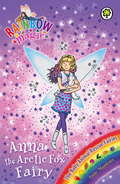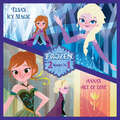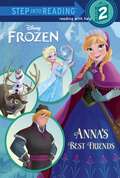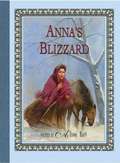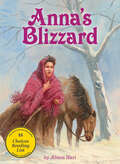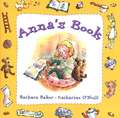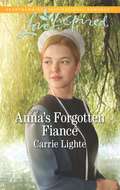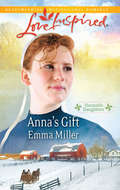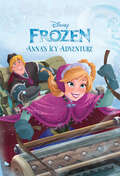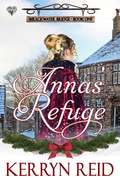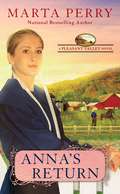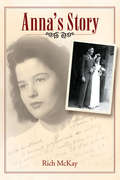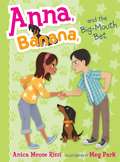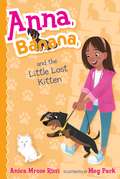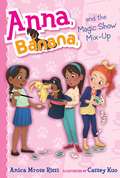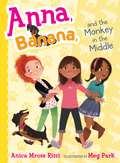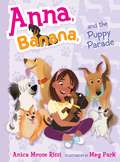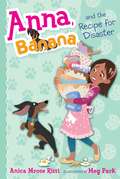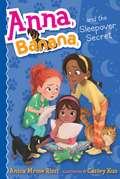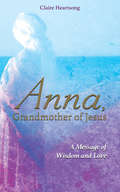- Table View
- List View
Anna the Arctic Fox Fairy: The Baby Animal Rescue Fairies Book 7 (Rainbow Magic #7)
by Daisy MeadowsGet ready for an exciting fairy adventure with the no. 1 bestselling series for girls aged 5 and up. Kirsty Tate and Rachel Walker are helping out at the Wild Woods Nature Reserve. They're having a great time meeting cute animals and making friends with the Animal Rescue Fairies. But when Jack Frost decides he wants baby animals for his own personal zoo, he steals the fairies' magical key rings. Can the girls help the fairies get their key rings back before the baby animals are trapped inside the Ice Lord's zoo for ever? 'These stories are magic; they turn children into readers!' ReadingZone.com Read all seven fairy adventures in the Baby Animal Rescue Fairies set! Mae the Panda Fairy; Kitty the Tiger Fairy; Mara the Meerkat Fairy; Savannah the Zebra Fairy; Kimberley the Koala Fairy; Rosie the Honey Bear Fairy; Anna the Arctic Fox Fairy. If you like Rainbow Magic, check out Daisy Meadows' other series: Magic Animal Friends and Unicorn Magic!
Anna to the Infinite Power
by Mildred AmesAnna is one of many clones of a scientific project and must consult a computer before doing anything. It turns out that Rowan, Anna's brother, does not like the fact that Anna is not human and ends up helping her. With time, Anna seems to be becoming human.
Anna's Act of Love/Elsa's Icy Magic (Disney Frozen)
by Disney PressFearless optimist Anna sets off on an epic journey—teaming up with rugged mountain man Kristoff and his loyal reindeer Sven—to find her sister Elsa, whose icy powers have trapped the kingdom of Arendelle in eternal winter. Encountering Everest-like conditions, mystical trolls and a hilarious snowman named Olaf, Anna, and Kristoff battle the elements in a race to save the kingdom. Children ages 3-7 will love this full-color storybook based on the film Disney Frozen.
Anna's Best Friends (Step into Reading)
by Christy WebsterWalt Disney Animation Studios, the studio behind Tangled and Wreck-It Ralph, presents Frozen, a stunning big-screen comedy-adventure. Fearless optimist Anna sets off on an epic journey—teaming up with rugged mountain man Kristoff and his loyal reindeer Sven—to find her sister Elsa, whose icy powers have trapped the kingdom of Arendelle in eternal winter. Encountering Everest-like conditions, mystical trolls, and a hilarious snowman named Olaf, Anna and Kristoff battle the elements in a race to save the kingdom. Girls and boys ages 4 to 6 will love this Step 1 Step into Reading leveled reader based on the film.
Anna's Blizzard
by Alison HartA dramatic story featuring a young Nebraska girl who discovers the courage to save others during a life-threatening snowstorm. It is 1888 and twelve-year-old Anna loves life on the Nebraska prairie where she lives with her parents and four-year-old brother in a simple sod house. She doesn't mind helping out with chores on her family's farm, especially when she is herding sheep with her beloved pony, Top Hat. Here, on the open prairie, Anna feels at home in the world. But at school she feels hopelessly out of place. Arithmetic is too hard, her penmanship is abysmal, and stuck-up Eloise Baxter always laughs at her mistakes. When a fierce blizzard suddenly kicks up on a mild winter day, Anna, her schoolmates, and young teacher, Miss Simmons, become trapped in the one-room schoolhouse. The kerosene is gone and the wood for the stove is low. Then the wind tears away the roof and door. Anna knows they must escape before it is too late. Does she have the courage and strength to lead the others through the whiteout to safety? Author Alison Hart offers young readers a dramatic story of rescue and survival set in a nineteenth century homesteading community and featuring a plucky, determined protagonist. An author's note provides more information about prairie life in the late nineteenth century and about the great storm that hit Nebraska in 1888, now known as "The School Children's Blizzard."
Anna's Blizzard
by Alison HartWhen a fierce blizzard suddenly kicks up on a mild winter day, a young Nebraska girl must find the courage and strength to lead others to safety in this novel inspired by the true story of the 1888 School Children's Blizzard.Twelve-year-old Anna loves life on the Nebraska prairie where she lives with her parents and four-year-old brother in a simple sod house. She doesn't mind helping out with chores, especially when she is herding sheep with her beloved pony, Top Hat. On the open prairie, Anna feels at home. But at school she feels hopelessly out of place. Arithmetic is too hard, her penmanship is abysmal, and stuck-up Eloise Baxter always laughs at her mistakes.When a unexpected blizzard traps Anna, her schoolmates, and their young teacher in the one-room schoolhouse, Anna knows they must escape before it is too late. Does she have the courage and strength to lead her class through the whiteout to safety?Alison Hart offers young readers a dramatic story of rescue and survival featuring a plucky, determined protagonist. An author's note provides more information about prairie life in the late nineteenth century and about the School Children's Blizzard.
Anna's Book
by Barbara BakerMeet Anna--she's exuberant and lovable, with a mind of her own. She has a new book, and she wants Mommy to read it again and again. Finally Mommy has to stop. Then Anna works out her own solution to her problem. Perfect for the attention span of toddlers, this satisfying little storybook shows us just what young children are like. So be ready to share it with your favorite toddler again and again.
Anna's Forgotten Fiancé (Amish Country Courtships Ser.)
by Carrie LighteBetrothed to a strangerThe Amish Country Courtships series continues!An accident leaves Anna Weaver with no memory of her Amish hometown’s newest arrival—her fiancé! After a whirlwind courtship, their wedding’s in six weeks…but how can she marry a man she can’t remember? Carpenter Fletcher Chupp takes her on a walk down memory lane, but there’s one thing he wants to keep hidden: a secret that might just lose him the woman he loves.
Anna's Gift
by Emma MillerNo one in Seven Poplars, Delaware, expects Anna Yoder ever to marry. Among her six pretty, petite sisters, big and plain Anna feels like a plow horse. But then Samuel Mast, the handsome widowed father she has secretly loved for years, asks if he can court her. Surely Anna has misheard-Samuel has his pick of lovely brides! She's convinced he seeks a wife only as a mother for his five children. Or could a man like Samuel actually have a very romantic reason for wanting Anna by his side forever?
Anna's Gift (The Latter-day Daughters)
by Carol Lynch WilliamsWhile living in Nauvoo, Illinois, in the mid-nineteenth century and enjoying the friendship of the Mormon prophet Joseph Smith, Anna struggles to make her family see the importance of her gift for drawing.
Anna's Icy Adventure (Disney Frozen)
by Disney PressFearless optimist Anna sets off on an epic journey—teaming up with rugged mountain man Kristoff and his loyal reindeer Sven—to find her sister Elsa, whose icy powers have trapped the kingdom of Arendelle in eternal winter. Encountering Everest-like conditions, mystical trolls and a hilarious snowman named Olaf, Anna and Kristoff battle the elements in a race to save the kingdom. Children ages 6-9 will love this chapter book based on Disney Frozen.
Anna's Refuge (Wrackwater Bridge #1)
by Kerryn ReidLewis Aubrey has grown up in the malignant shadow of his brother, Gideon. In London for the first time, with no thought of love, he is beguiled by Miss Anna Spain. Gideon steals her away, and then tosses her aside like a trampled rose. Months later, horrified to learn that Anna carries Gideon’s child, Lewis tracks her down amid the grit of industrial Leeds. He’s desperate to protect her—but can he survive marriage, believing she still yearns for his brother? Trusting and naïve, dreaming of a love that’s glorious and timeless, Anna falls for Gideon Aubrey and his lies. When he casts her aside in the middle of a ball, Lewis shields her from gossip. He becomes her rock in a world of anguish, and she grows to love him very much indeed. But what kind of woman would condemn a man to a marriage he cannot possibly want, raising a child not his own? Somehow, these two tattered souls must escape Gideon’s shadow and find their way to happiness, for the child’s sake…and for their own.
Anna's Return
by Marta PerryMarta Perry returns with a brand-new inspirational Pleasant Valley novel. After spending three years in the English world, Anna Beiler returns to the Pleasant Valley Amish with a baby girl, which will surely cause a stir since Anna is unmarried. What they don't know is that the baby is adopted, and Anna desperately needs to protect it from its violent father... Anna finds it reassuring to reconnect with family and old friends. But she hasn't fully faced the consequences of her irresponsible youth. And now she may be endangering her family. If she wants to stay, she must seek forgiveness from the community whose blessing she took for granted, and experience the true change of heart required to make a new beginning.
Anna's Story (Anna's Story Ser.)
by Rich McKayAn immigrant woman reflects on her past in Germany before, during, and after World War II, as well as finding love, family, and a future in America. This is the remarkable life story of Anna Burkardt McKay, who was born in Germany before WWII and who moved to the United States as an American war bride in 1947 to raise a family on a small cattle ranch in Nevada. Through a childhood in Hochst, Germany, where fond memories mingle with remembrances of the horrors of the Second World War&’s beginning; into a young adulthood, filled with terrors of the escape and evasion of Nazi youth work camps; through falling in love and immigrating to the United States to marry, and later have a family, this is Anna&’s Story.
Anna's Summer Songs
by Mary Q. SteeleTrees, flowers, ferns, and fruit-- Anna's joyous songs celebrate everything that grows. Delightful children's poetry with picture descriptions present.
Anna, Banana, and the Big-Mouth Bet: Anna, Banana, And The Friendship Split; Anna, Banana, And The Monkey In The Middle; Anna, Banana, And The Big-mouth Bet; Anna, Banana, And The Puppy Parade (Anna, Banana #3)
by Anica Mrose RissiAnna finds herself standing up to the class clown in the third book of a charming illustrated chapter book series about the joys and challenges of elementary school friendships.Anna has a loose tooth! It’s as wiggly as her dog Banana’s tail. But when Anna is poking at her loose tooth, class clown Justin keeps poking fun at Anna and her friends. Anna tries to make Justin leave them alone and gets pulled into a high-stakes bet. If Anna wins, Justin has to play nice; but if Anna loses, she has to do something so jaw-droppingly embarrassing, even Banana can’t believe it. There’s no wiggling her way out of this one. Anna has to win this bet.
Anna, Banana, and the Friendship Split: Anna, Banana, And The Friendship Split; Anna, Banana, And The Monkey In The Middle; Anna, Banana, And The Big-mouth Bet; Anna, Banana, And The Puppy Parade (Anna, Banana #1)
by Meg Park Anica Mrose RissiMeet Anna and her beloved wiener dog, Banana, in this start to a charming illustrated chapter book series about the joys and challenges of elementary school friendships.Anna has been best friends with Sadie for as long as she can remember. So Anna is utterly perplexed when, on Anna's birthday, Sadie unceremoniously stakes claim to Anna's new pony necklace, then suddenly stops speaking to Anna altogether. Did Anna do something wrong? With a little help from her wiener dog, Banana, as well as some sage advice from her family, Anna makes some important discoveries about what it means to stand up for herself, and how to be a true friend.
Anna, Banana, and the Little Lost Kitten (Anna, Banana #5)
by Meg Park Anica Mrose RissiAnna and Banana rescue a stray kitten in the fifth book of this “fast-paced, fun, and funny” (Megan McDonald, bestselling author of the Judy Moody series) illustrated chapter book series about the joys and challenges of elementary school friendships.Anna and Banana have found a kitten! But when Banana accidentally scares the kitten away during their afternoon walk, Anna enlists her two best friends, Sadie and Isabel, for OPERATION CATCH THE KITTEN. Anna can’t image such a tiny kitten living outside all by himself, and she’s determined to find him a good home. But catching a kitten is trickier than Anna thought—kittens are easily scared and very stealthy. Then there’s the problem of finding him a good home. Sadie’s mom has a “No Pets” rule, Isabel’s cat, Mewsic, does not play well with other animals, and Anna’s dad is allergic to cats! Anna and her friends desperately want to help, but will they be able to find the kitten a good home?
Anna, Banana, and the Magic Show Mix-Up (Anna, Banana #8)
by Anica Mrose RissiWhen preparing for a magic show, Anna and her friends find a talent for trouble instead in the eighth book of this &“fast-paced, fun, and funny&” (Megan McDonald, bestselling author of the Judy Moody series) illustrated chapter book series about the joys and challenges of elementary school friendships.Anna, Sadie, and Isabel develop an interest in magic tricks when their frenemy Justin mystifies them with a cool card trick but refuses to tell them how he did it. Determined to figure it out for themselves, the girls set out for the best place to find answers—the library!—ready to learn every magic trick in the book. But magic isn&’t as easy as it appears, even with a book of instructions. When Anna goes to her neighbor Mrs. Shirley for advice, she finds out that while Mrs. S doesn&’t know any magic tricks herself, her very favorite birthday party ever was a magician show where the magician pulled a rabbit out of a hat. With the neighborhood potluck coinciding with Mrs. Shirley&’s seventy-sixth birthday, Anna and her friends decide to practice their own magic act to perform for her, but a whole slew of mix-ups ensue as they try to puzzle out how the tricks are done and how to figure out Justin&’s secret, too. Can Anna and her friends perform some magic and get the mix-ups under control before—presto—it&’s showtime?
Anna, Banana, and the Monkey in the Middle: Anna, Banana, And The Friendship Split; Anna, Banana, And The Monkey In The Middle; Anna, Banana, And The Big-mouth Bet; Anna, Banana, And The Puppy Parade (Anna, Banana #2)
by Meg Park Anica Mrose RissiAnna finds herself torn between two friends in the second book of a charming illustrated chapter book series about the joys and challenges of elementary school friendships.Sadie and Isabel are Anna's two best friends, and Anna can't wait to go with them on the class field trip to the zoo--but she keeps getting caught in the middle. Isabel wants Anna to see the tortoise with her, but Sadie wants to see the spiny anteater. Isabel wants to do their group report on giant pandas, while Sadie wants them to write about zebras. With a little help from her beloved dog, Banana, as well as some wise advice from her family, can Anna figure out what it means to be a best friend to two very different people--and still be a friend to herself?
Anna, Banana, and the Puppy Parade: Anna, Banana, And The Friendship Split; Anna, Banana, And The Monkey In The Middle; Anna, Banana, And The Big-mouth Bet; Anna, Banana, And The Puppy Parade (Anna, Banana #4)
by Anica Mrose RissiAnna enters her beloved dog Banana in a contest in the fourth book of this “fast-paced, fun, and funny” (Megan McDonald, bestselling author of the Judy Moody series) illustrated chapter book series about the joys and challenges of elementary school friendships.Anna can’t wait for the Puppy Parade. She’s certain Banana will win. Soon Banana will be famous—and that means Anna will be famous, too! But when Sadie and Isabel suggest they all enter the parade together, Anna starts feeling a little unsure about sharing her dog—and the spotlight—with her friends. How can Anna be Best in Show and a good best friend?
Anna, Banana, and the Recipe for Disaster (Anna, Banana #6)
by Meg Park Anica Mrose RissiAnna and Banana must cook up a solution when her jealousy gets her into some hot water in the sixth book of this “fast-paced, fun, and funny” (Megan McDonald, bestselling author of the Judy Moody series) illustrated chapter book series about the joys and challenges of elementary school friendships.After watching the contestants on The Batter-Up Bake-Off Show whip up sweet treats, Anna, Isabel, Sadie, and Banana are ready to put their culinary chops to the test. The plan? To make the best-ever cookie recipe for the town library’s bake sale! There’s only one problem: Isabel and Sadie have started hanging out with a girl named Monica, and suddenly she’s all they can talk about. Anna’s sure she, Sadie, and Isabel are complete as a trio, and winning the bake sale will prove it. But when Monica shows up with Sadie and Isabel for their big baking day things quickly turn from sweet to sour. Can Anna win back the attention of her two besties, or will she learn that friendship—like cookies—is best when shared?
Anna, Banana, and the Sleepover Secret (Anna, Banana #7)
by Anica Mrose Rissi Cassey KuoAnna wrestles with a big secret at Isabel’s super-fun sleepover in the seventh book of this “fast-paced, fun, and funny” (Megan McDonald, bestselling author of the Judy Moody series) illustrated chapter book series about the joys and challenges of elementary school friendships.Anna and her friends love having sleepovers. So, when Isabel invites Anna and Sadie to spend the night at her house for the first time Anna can’t wait! Between pranking Isabel’s older sisters, make-your-own pizzas, and truth or dare this is going to be the best night ever. But when one of Isabel’s older sisters’ dares results in Anna breaking a really special vase, everything stops being all fun and games. Isabel’s sisters convince the girls they can hide it from their parents, but after her friends fall asleep, Anna lies on the floor in her sleeping bag, wide awake. At night, with the lights out and everyone else sleeping, Isabel’s house seems different. Unfamiliar. Not like home. Anna misses Banana terribly, and worst of all she feels really guilty keeping what happened a secret. If Anna doesn’t stay at the sleepover, everyone might get mad at her for ruining it, but if she stays and lets the secret slip about the broken vase, everyone might get mad at her for that instead. Anna and her friends share all their secrets, but can they help her with her secret dilemma?
Anna, Grandmother of Jesus: A Message of Wisdom and Love
by Claire Heartsong Claire Ann ClemettThe self-published spiritual word-of-mouth bestseller.Anna, Grandmother of Jesus became a publishing sensation when the self-published version sold 50,000 copies through word of mouth alone, amassing a worldwide following in the process.Anna is the mother of the Virgin Mary and the grandmother of Jesus. Her teachings and service birthed a spiritual lineage that changed the world. In this book, you'll discover missing pieces of history concerning Anna, Mary and Jesus, as channelled by Claire Heartsong, who has been receiving telepathic messages from Anna for 30 years.Told through the gentle and heartwarming voice of Anna herself, this book offers insights into unknown places the holy family visited, people they knew and intimate details of their daily struggle to complete the Resurrection challenges. You will learn about the Essenes of Mount Carmel and their secret teachings and initiations, and gain a new understanding of Jesus's mission.Containing encoded activations to bring Anna's wisdom and energy into your own spiritual life, this book is an invitation to complete a journey of initiation begun long ago.
